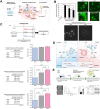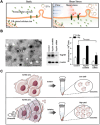Physicochemical Modulation Strategies for Mass Production of Extracellular Vesicle
- PMID: 40471522
- PMCID: PMC12209107
- DOI: 10.1007/s13770-025-00726-9
Physicochemical Modulation Strategies for Mass Production of Extracellular Vesicle
Abstract
Background: Extracellular vesicles (EVs) have attracted expanded attention as vehicles for the diagnosis and therapy of diseases and regenerative medicine due to their biocompatibility, efficient cellular uptake ability, and capacity to transport biologically active molecules. However, the low secretion yield of EVs and the challenges of large-scale production remain the main barriers to their extensive clinical use.
Methods and results: This review explores recent strategies to enhance EV production in cell culture systems, focusing on chemical stimulation, mechanical stimulation, and structural stimulation. First, we review chemical stimulation strategies for modulating culture conditions using chemical stimulation, including nutrient composition, pH, temperature, oxygen levels, intracellular cholesterol, and oxidative stress. Second, we examine mechanical stimulation strategies, including shear stress, irradiation, and ultrasound. Third, we explore structural stimulation strategies, such as three-dimensional (3D) culture systems involving spheroid-based culture, as well as the use of bioreactors and scaffolds. In addition, cell-derived nanovesicles containing cell membrane and cellular component, which can be more easily mass-produced compared to EVs, are proposed as an alternative to EVs.
Conclusion: Future research should focus on developing cost-effective and scalable EV production methods while improving purification techniques to ensure a high yield without compromising functional integrity. Moreover, integrating optimized stimulation strategies-such as refining 3D culture systems, bioreactor designs, and mechanical stimulation methods-could further enhance EV secretion. Addressing these challenges is essential for advancing EV-based applications in both research and clinical practice.
Keywords: 3D culture system; Chemical modulation; EV mimetic nanovesicles; Extracellular vesicle; Mass production; Mechanical modulation.
© 2025. The Author(s).
Conflict of interest statement
Declarations. Conflict of interest: The authors have no financial conflicts of interest. Ethical statement: There are no animal experiments carried out for this article.
Figures



Similar articles
-
Advancing extracellular vesicle production: improving physiological relevance and yield with 3D cell culture.Nanoscale. 2025 Jun 26;17(25):15110-15131. doi: 10.1039/d5nr00707k. Nanoscale. 2025. PMID: 40512034 Review.
-
Culture of Hoffa fat pad mesenchymal stem/stromal cells on microcarrier suspension in vertical wheel bioreactor for extracellular vesicle production.Stem Cell Res Ther. 2024 Mar 5;15(1):61. doi: 10.1186/s13287-024-03681-9. Stem Cell Res Ther. 2024. PMID: 38439108 Free PMC article.
-
Transitioning from static to suspension culture system for large-scale production of xeno-free extracellular vesicles derived from mesenchymal stromal cells.Biotechnol Prog. 2024 May-Jun;40(3):e3419. doi: 10.1002/btpr.3419. Epub 2024 Jan 21. Biotechnol Prog. 2024. PMID: 38247123
-
A practical protocol for correlative confocal fluorescence and transmission electron microscopy characterization of extracellular vesicles.Microbiol Spectr. 2025 Jul;13(7):e0302624. doi: 10.1128/spectrum.03026-24. Epub 2025 May 22. Microbiol Spectr. 2025. PMID: 40401966 Free PMC article.
-
Extracellular Vesicle-Integrated Biomaterials in Bone Tissue Engineering Applications: Current Progress and Future Perspectives.Int J Nanomedicine. 2025 Jun 17;20:7653-7683. doi: 10.2147/IJN.S522198. eCollection 2025. Int J Nanomedicine. 2025. PMID: 40546799 Free PMC article. Review.
References
-
- Cheng K, Kalluri R. Guidelines for clinical translation and commercialization of extracellular vesicles and exosomes based therapeutics. Extracell Vesicle. 2023;2:100029.
Publication types
MeSH terms
Grants and funding
- NRF-2022R1A2C3004850/Ministry of Science and ICT, South Korea
- RS-2024-00449435/Ministry of Science and ICT, South Korea
- RS-2023-00257290/Ministry of Science and ICT, South Korea
- RS-2023-00246418/National Institute for International Education
- RS-2023-00275501/National Institute for International Education
LinkOut - more resources
Full Text Sources
